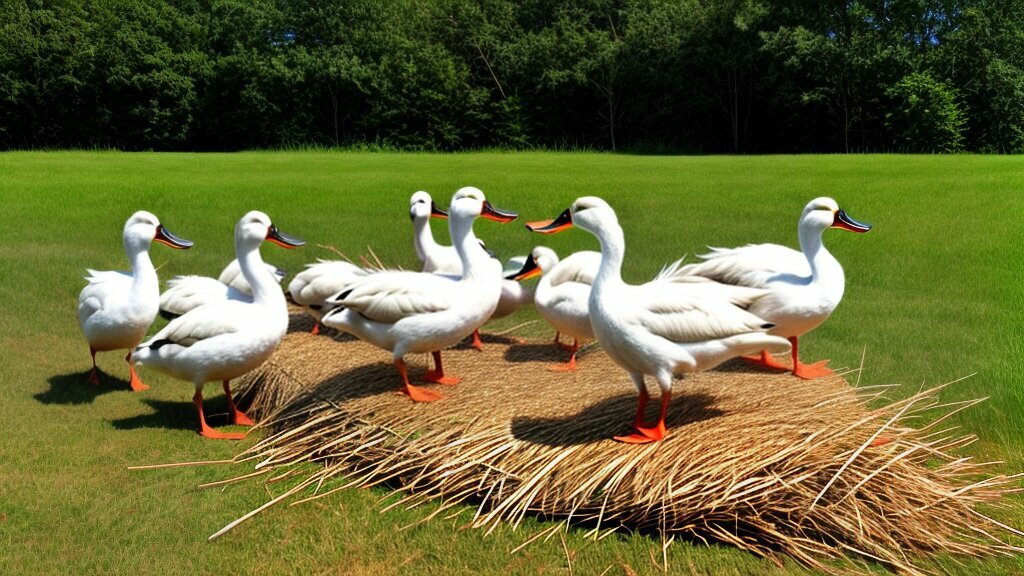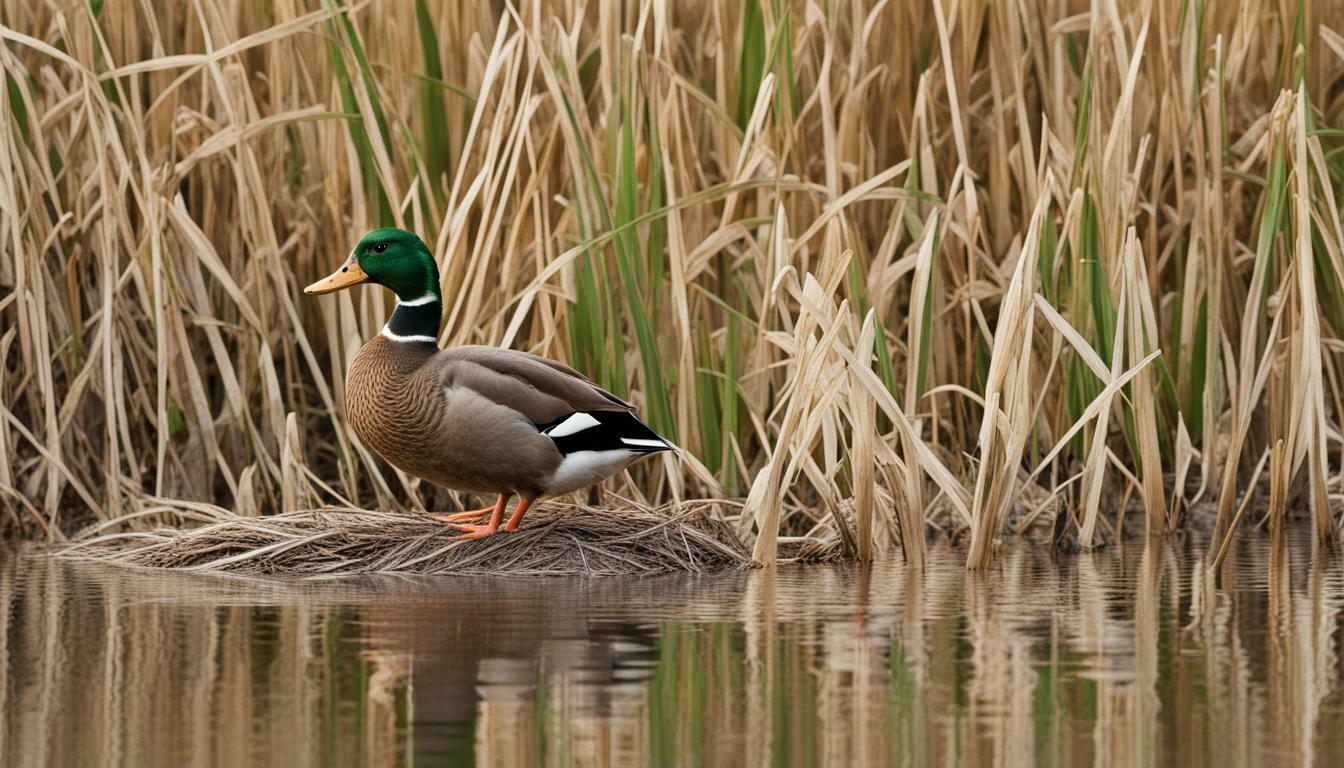Do Ducks Eat Hay? A Deep Dive into Ducks’ Diets

Table of content:
When you imagine a duck’s natural diet, a pile of dry hay probably doesn’t come to mind. Yet the question remains – do ducks eat hay at all? As with most things in nature, the answer depends on whether we’re talking about wild ducks or domestic ducks. In this article, we’ll take a deep dive into the dietary preferences of our feathered friends. Read on to learn what foods make up the bulk of a duck’s nutritious diet and where hay fits in, if at all.
Omnivorous Diet of Wild Ducks
Wild ducks thriving in ponds, marshes, and rivers worldwide are opportunistic omnivores. This means they eat a varied diet consisting of plants, seeds, insects, worms, fish, amphibians and other aquatic creatures.
A duck’s bill contains many sensitive nerves, making it an excellent tool for locating food. Ducks spend much of their day submerged, dabbling at the surface or tipping tail-up to forage underwater. Their diverse diet provides the protein, carbohydrates, vitamins and minerals wild ducks need to survive.
Common foods found in a wild duck’s diet include:
- Aquatic plants – Examples include pondweeds, watercress, wild celery and wild rice. Ducks graze heavily on aquatic vegetation.
- Seeds – Ducks will eat a variety of plant seeds filtered from the water or foraged from mud. Common examples are seeds from grasses, sedges, grains, flowering plants and wetland trees like oak and elm.
- Insects – Ducklings eat mainly insects like midges, flies, beetles, dragonflies, damselflies, and caddisflies. Adults ducks eat fewer insects but still consume their share.
- Crustaceans – Ducks will eat small crustaceans like freshwater shrimp, crayfish, and other aquatic zooplankton.
- Mollusks – Snails and mussels are food sources ducks gravitate towards for their protein content.
- Tadpoles and Frogs – Adults and ducklings will consume small aquatic frogs and tadpoles.
- Fish – Small fish like minnows often make up part of the duck diet.
As you can see, a natural wild duck diet is diverse and takes advantage of the great bounty wetland environments provide. Noticeably absent from a wild duck’s menu is dry hay, which holds little appeal as a food source.
Farmed Ducks Rely on Humans for Food
Domestic ducks raised on farms for eggs, meat, down and as pets have a different dietary reality than their wild counterparts. Farmed ducks are largely dependent on humans to provide their daily food. But what do ducks eat when raised in captivity?
The majority of domestic ducks’ calories should come from complete, balanced duck feed purchased from a farm supply store. This commercial feed contains a mix of grains, protein sources, vitamins and minerals tailored to a duck’s needs. Common ingredients are:
- Grains – Examples are corn, wheat, barley, milo, oats. Grains provide carbohydrates.
- Proteins – Soybean meal, fish meal, and lentils supply essential amino acids.
- Calcium – Needed for egg shell strength and skeletal health.
- Grit – Provides ducks with minerals and helps grind food in gizzard.
This complete feed can be offered free choice as pellets, crumbles, or mash. Farmers also supplement with corn, oats, barley, and other grains as additional calories.
Some duck owners prefer mixing their own feed using purchased grain mixes, soybean meal for protein, oyster shell for calcium, and vitamins/minerals. Home mixed rations should be carefully researched to ensure proper nutrition.
Role of Hay in a Domestic Duck’s Diet
So where does hay fit into a domestic duck’s diet? Hay can play a role, but is not an adequate substitute for commercial feed.
Hay is dried grass or legume plants like alfalfa and clover. It provides roughage that aids digestion and provides small amounts of protein and nutrients. The most common hays fed to livestock are:
- Alfalfa – High protein levels around 15-20% make alfalfa a useful addition to a duck’s diet. But too much alfalfa can be problematic.
- Timothy – Lower in protein than alfalfa, but the most prevalent grass hay.
- Clover – Usually fed mixed with grasses. Higher protein levels than grass hay.
Farmers may offer hay to confined domestic ducks to supplement commercial rations. The hay gives ducks something to pick at and provides roughage to aid digestion.
But hay alone is not a complete diet. Ducks allowed to free-range can obtain some nutrition from grazing on fresh grasses and plants. But much of their food should still come from a balanced commercial ration.
Considerations in Feeding Hay to Ducks
Hay can add some variety to a domestic duck’s diet, but should not make up the bulk of what they eat. Here are some key considerations when including hay:
- Nutritional content – Grass hays like timothy are lower in protein, while legume hays like alfalfa tend to be higher. But neither can fully meet a duck’s nutritional needs alone.
- Supplementation – Ducks should eat hay alongside commercial feed to achieve a balanced diet.
- Duckling hazard – Hay may pose a choking hazard for young ducklings. Chopped hay is safer. Avoid feeding ducklings alfalfa as it is too high in protein.
- Cleanliness – Wet, moldy hay can pose health risks. Store hay properly and prevent contamination from rodents.
- Prevent waste – Use hay racks to keep hay clean and reduce waste.
Hay can add fiber and keep confined ducks occupied. But a commercial complete feed should provide the foundation of any domestic duck’s diet.
Unique Dietary Needs of Pet Ducks
Keeping ducks as pets or backyard poultry is becoming more popular. But even tame pet ducks have their own dietary needs. Following the same principles as commercial duck farming will help provide pet ducks the proper nutrition.
Here are some tips on feeding pet ducks:
- Select a complete commercial duck ration as the dietary foundation. Look for products labeled as “all flock” or “maintenance” feed.
- Supplement feed with grain mixes, fresh greens, vegetables and limited amounts of hay for variety.
- Offer grit to aid digestion, along with oyster shell for calcium.
- Ensure easy access to clean, fresh water for drinking and bathing.
- Scatter feed over a large area to encourage natural foraging behavior.
- Pet ducks may require different feed in winter vs. summer. Research seasonal nutritional needs.
- Avoid copper in feed and water as ducks are sensitive to its toxicity.
With the right diet, it’s possible to keep healthy and thriving pet ducks for many years. Learning their unique nutritional needs goes a long way.
Conclusion: Do Ducks Eat Hay?
After taking a deep dive into the dietary needs of wild, farmed, and pet ducks, we can better answer the original question – do ducks eat hay?
The simple answer is that wild ducks do not seek out dry hay as a substantial part of their omnivorous wetland diet. Hay holds little appeal to a wild duck filtering through water for aquatic plants and invertebrates.
Domestic ducks, on the other hand, can eat limited amounts of hay as part of a balanced diet. Farmers may offer hay for roughage, interest, and fiber. Alfalfa and clover hay have more nutritional value than plain grass hays. But hay alone does not meet the requirements of domestic ducks, who need balanced commercial feed rations to thrive.
It’s fine for duck owners to offer limited hay as a supplement to commercial duck feed. But for the healthiest, happiest ducks, a complete species-specific diet should always be the foundation
Welcome. I’m Adreena Shanum, the proud owner of this website, and I am incredibly passionate about animals, especially poultry. I founded adreenapets.com as a labor of love, stemming from my desire to share my knowledge and experiences with poultry enthusiasts worldwide.




